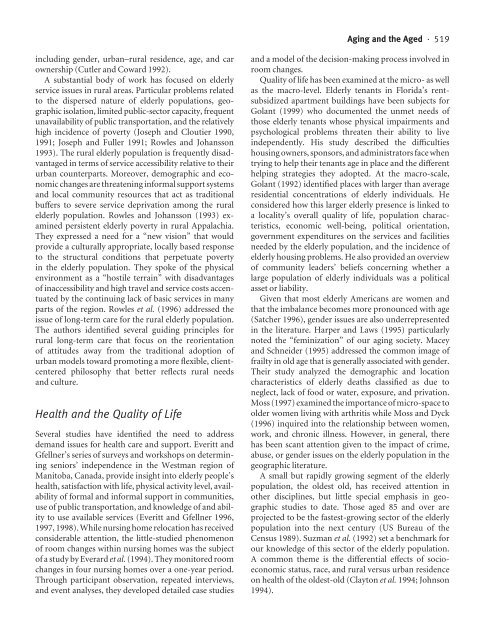Geography in America at the Dawn of the 21st Century
Geography in America at the Dawn of the 21st Century
Geography in America at the Dawn of the 21st Century
Create successful ePaper yourself
Turn your PDF publications into a flip-book with our unique Google optimized e-Paper software.
concerned with <strong>the</strong> importance <strong>of</strong> specific places <strong>in</strong> <strong>the</strong><br />
geography <strong>of</strong> global flows.<br />
As important as economic globaliz<strong>at</strong>ion has been for<br />
cities, <strong>the</strong> transform<strong>at</strong>ion wrought by cultural globaliz<strong>at</strong>ion<br />
(whe<strong>the</strong>r th<strong>at</strong> is understood <strong>in</strong> terms <strong>of</strong> <strong>the</strong> globaliz<strong>at</strong>ion<br />
<strong>of</strong> media images and p<strong>at</strong>terns <strong>of</strong> consumption, or<br />
new migr<strong>at</strong>ions) is <strong>at</strong> least as important. For example,<br />
Maoz Azaryahu (1999) argues th<strong>at</strong> controversy over <strong>the</strong><br />
sit<strong>in</strong>g <strong>of</strong> a McDonald’s close to an Israeli war memorial<br />
was as much about <strong>the</strong> endorsement and adoption <strong>of</strong><br />
<strong>America</strong>n values as it was about <strong>the</strong> commodific<strong>at</strong>ion <strong>of</strong><br />
a sacred space. It is also about appropri<strong>at</strong>e symbolic distances<br />
and barriers (<strong>the</strong> McDonald’s was more acceptable<br />
when its “golden arches” were de-emphasized and<br />
<strong>the</strong> smell from <strong>the</strong> deep-fryers was filtered). Marcuse<br />
(1995) articul<strong>at</strong>es this <strong>the</strong>oretically by not<strong>in</strong>g th<strong>at</strong> <strong>the</strong><br />
“globaliz<strong>at</strong>ion <strong>of</strong> <strong>the</strong> city” has led to new sp<strong>at</strong>ial<br />
configur<strong>at</strong>ions <strong>of</strong> urban space. This space is not <strong>at</strong> all<br />
marked by openness (as <strong>the</strong> image <strong>of</strong> a borderless world<br />
<strong>the</strong> very notion <strong>of</strong> “globaliz<strong>at</strong>ion” plays upon) but<br />
<strong>in</strong>stead by walls. Specifically, Marcuse argues th<strong>at</strong> <strong>in</strong> contemporary<br />
technologically advanced cities, five dist<strong>in</strong>ctive<br />
types <strong>of</strong> residential area are emerg<strong>in</strong>g: elite quarters<br />
built as enclaves and isol<strong>at</strong>ed build<strong>in</strong>gs which also serve<br />
as a site for “command and control” functions for <strong>the</strong><br />
city and economy (see also Dear and Flusty 1998; K<strong>in</strong>g<br />
1999); gentrified districts occupied largely by <strong>the</strong><br />
“transn<strong>at</strong>ional producer-services class” and <strong>the</strong> cultural<br />
workers <strong>of</strong> <strong>the</strong> global city; a suburban city for skilled<br />
workers, civil servants, and middle-level pr<strong>of</strong>essionals; a<br />
tenement district occupied by immigrants and o<strong>the</strong>r<br />
low-paid workers; and “an abandoned city, <strong>the</strong> end<br />
result <strong>of</strong> trickle-down, left for <strong>the</strong> poor, <strong>the</strong> unemployed,<br />
<strong>the</strong> excluded” (Marcuse 1995: 246). The irony, Marcuse<br />
suggests, is th<strong>at</strong> <strong>in</strong> such a city it is <strong>the</strong> walls (both real and<br />
metaphorical) r<strong>at</strong>her than <strong>the</strong> connections between <strong>the</strong><br />
quarters <strong>of</strong> <strong>the</strong> city th<strong>at</strong> are <strong>of</strong> most importance. The city,<br />
he argues, is <strong>at</strong> its most divided <strong>at</strong> least s<strong>in</strong>ce <strong>the</strong> medieval<br />
period (see also Davis 1990).<br />
The “global city”—whe<strong>the</strong>r seen <strong>in</strong> terms <strong>of</strong> economics,<br />
culture, or urban structure—and <strong>the</strong> reconfigur<strong>at</strong>ion<br />
<strong>of</strong> geographical scale—whe<strong>the</strong>r seen as an<br />
economic process, a po<strong>in</strong>t <strong>of</strong> political struggle, or a form<br />
<strong>of</strong> social rel<strong>at</strong>ions—<strong>in</strong>dic<strong>at</strong>e a pr<strong>of</strong>ound transform<strong>at</strong>ion<br />
<strong>in</strong> <strong>the</strong> way urban life is lived. The important po<strong>in</strong>t<br />
th<strong>at</strong> needs stress<strong>in</strong>g here is th<strong>at</strong> urban represent<strong>at</strong>ions<br />
are not just about mean<strong>in</strong>g but also about <strong>the</strong> m<strong>at</strong>erial<br />
conditions <strong>of</strong> day-to-day life <strong>in</strong> cities and how <strong>the</strong>se<br />
m<strong>at</strong>erial conditions change. The “urban problem<strong>at</strong>ic” is<br />
every bit as important to understand now as it was when<br />
Marston and her colleagues tried to come to terms with<br />
<strong>the</strong> eclecticism th<strong>at</strong> c<strong>at</strong>egorized urban geography a<br />
decade ago. While changes <strong>in</strong> urban <strong>the</strong>ory have cre<strong>at</strong>ed<br />
new avenues for research, even more important have<br />
been changes <strong>in</strong> <strong>the</strong> spaces <strong>of</strong> cities <strong>the</strong>mselves—<strong>the</strong><br />
rapid urban restructur<strong>in</strong>g th<strong>at</strong> marked <strong>the</strong> last quarter <strong>of</strong><br />
<strong>the</strong> century. The balance <strong>of</strong> this chapter <strong>at</strong>tempts to chart<br />
just a few <strong>of</strong> <strong>the</strong> transform<strong>at</strong>ions <strong>in</strong> urban space and<br />
urban <strong>the</strong>ory—and lived experience.<br />
Urban Transform<strong>at</strong>ions<br />
Urban <strong>Geography</strong> · 249<br />
Tiananmen, Leipzig, Berl<strong>in</strong>, Prague, Budapest, Bucharest.<br />
As protestors <strong>in</strong> 1989 took to parks, streets,<br />
squares, and town centers across Asia and Eastern<br />
Europe, events clearly <strong>in</strong>dic<strong>at</strong>ed <strong>the</strong> vital importance <strong>of</strong><br />
urban space to political control—its structure and represent<strong>at</strong>ion,<br />
its use and occup<strong>at</strong>ion, its power and control.<br />
The revolutions <strong>of</strong> 1989 were not only revolutions <strong>in</strong> <strong>the</strong><br />
halls <strong>of</strong> government; <strong>the</strong>y were popular upris<strong>in</strong>gs fill<strong>in</strong>g<br />
<strong>the</strong> very urban spaces th<strong>at</strong> had to this po<strong>in</strong>t provided <strong>the</strong><br />
sett<strong>in</strong>g for <strong>the</strong> reproduction <strong>of</strong> <strong>the</strong> society <strong>the</strong> people<br />
were protest<strong>in</strong>g aga<strong>in</strong>st. By transform<strong>in</strong>g space, society<br />
itself was transformed (Lefebvre 1991).<br />
In <strong>the</strong> decades surround<strong>in</strong>g 1989, <strong>America</strong>n and<br />
Western European urban streets and parks were caught<br />
up <strong>in</strong> <strong>the</strong> urban restructur<strong>in</strong>g th<strong>at</strong> accompanied wh<strong>at</strong><br />
Harvey (1989) identified as a thorough sea change <strong>in</strong> <strong>the</strong><br />
global political economy and were transformed by <strong>the</strong><br />
explosive growth <strong>of</strong> homelessness (Dear and Wolch<br />
1987; Takahashi 1996; Wolch and Dear 1996). Women<br />
and children, men both young and old, people <strong>of</strong> color as<br />
well as whites, found <strong>the</strong>mselves thrown onto <strong>the</strong> streets,<br />
<strong>the</strong>re to make wh<strong>at</strong>ever life <strong>the</strong>y could <strong>in</strong> <strong>the</strong> put<strong>at</strong>ively<br />
public spaces <strong>of</strong> <strong>the</strong> city. Meanwhile, <strong>the</strong> urban and<br />
suburban middle classes more and more found <strong>the</strong>ir<br />
enterta<strong>in</strong>ment <strong>in</strong> <strong>the</strong> spaces <strong>of</strong> <strong>the</strong> mall and festival marketplace,<br />
spaces <strong>the</strong>mselves th<strong>at</strong> seemed to portend a<br />
new rel<strong>at</strong>ionship between property, citizenship, and consumption.<br />
By <strong>the</strong> beg<strong>in</strong>n<strong>in</strong>g <strong>of</strong> <strong>the</strong> 1990s, <strong>the</strong> cont<strong>in</strong>ued<br />
rapid pace <strong>of</strong> urban restructur<strong>in</strong>g contributed to a<br />
grow<strong>in</strong>g sense <strong>of</strong> wh<strong>at</strong> some analysts describe as a “crisis”<br />
<strong>of</strong> <strong>the</strong> city: an end to urbanity and all th<strong>at</strong> has implied for<br />
<strong>the</strong> construction <strong>of</strong> a vibrant public sphere (Berman<br />
1984; 1986; Davis 1990, 1998; Goheen 1994, 1998; Zuk<strong>in</strong><br />
1995). Some have argued th<strong>at</strong> this transform<strong>at</strong>ion has<br />
led to cities characterized by fragmented social and<br />
sp<strong>at</strong>ial rel<strong>at</strong>ions <strong>in</strong> which <strong>the</strong> construction <strong>of</strong> a “public”<br />
is impossible. At <strong>the</strong> same time, o<strong>the</strong>rs note th<strong>at</strong> <strong>the</strong>

















